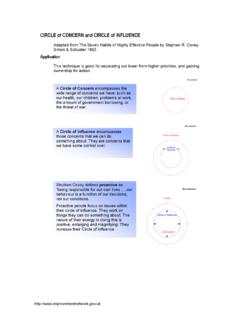Transcription of FOCUSING--ORIENTED-EXPERIENTIAL PSYCHOTHERAPY: …
1 Theory, Research, Practice, Training, 33, 262-274. Williams, L. (2010). Makin g contact with the self-injurious adolescent: Bo rderline personality d isorder, Gestalt therapy, and dialectical beh avioral therapy inter-ventions. Gestalt Review, 14, 250-274. Yontef, G., & Bar-Joseph Levine, T. (2008). D ia logical re lationship. In P. Brownell (Ed.), Handbook for theory, research, and practice in Gestalt therapy (pp. 184-197). Newcastle, England: Cambridge Scholars. Yontef, G., & Fuhr, R. (2005 ). Gestalt the rapy theory of change. In A. Woldt & S. Toman (Eds.), Gestalt therapy history, theory, and p-ractice (pp . 81-100).
2 Thou-sand Oaks, CA: Sage. Young, J. (2005 ). Schema-focused cognitive therapy in the treatment of Ms. S. Jour-nal of Psychotherapy Integration, 15, 115- 126. Yousefi, N., Etemadi, 0., Bahrami, E, Fatehizadeh, M., Ahmadi, S., Mavarani, A., Botlani, S. (2009). Efficacy oflogo therapy and Gestalt therapy in treating anxiety, depression and aggression. journal of Iranian Psychologists, 5, 251- 259. Ziv-Beiman , S. (2013 ). Therapist self-disclosure as an integrative intervention. journal of Psychotherapy Integration, 23, 59- 74. h a0031783 250 PHILIP BROWNELL 8 FOCUSING--ORIENTED-EXPERIENTIAL PSYCHOTHERAPY: FROM RESEARCH TO PRACTICE KEVIN C.
3 KRYCKA AND AKIRA IKEMI With more than 50 years of studies demonstrating the usefulness of focusing -ori en ted-experient ial therapy (FOT), new research findings have provided further evidence of its efficacy in the treatment of vari ous psycho-logical disorders and issues. Traditional outcome research studies are being augmented by other microprocess-oriented studies, which look closely at the small change events clients and therapists report when reflecting on therapy. Microprocess research on FOT represents a growing body of research that illuminates th ese small steps of therapeutic change found in FOT sessions and provides practitioners with further evidence of h ow and why FOT works.
4 This chapter includes a summary of the research on FOT since the last review conducted by Hendricks (2002), wh o looked at 89 empirical experi-mental research stud ies on focusing and focusing -oriented therapy, mainly those using the Experiencing Scale (Klein , Mathieu, Gendlin, & Kiesler, 1969; Klein, We thank Toshihiro Kawasaki for his efforts in identifying and organizing studies conducted in Japan. 7/14 775-009 Humanistic Psychotherapies: Handbook of Research and Practice, Second Edition, D. J. Cain, K. Keenan, and S. Rubin (Editors) Copyright 2016 by the American Psychological Association. All rights reserved.)
5 251 Mathieu-Coughlan, & Kiesler, 1986). This summary positively correlates expe-riencing level and participant-reported positive therapy outcome. We present a discussion of the philosophical foundation for FOT. We also include transcripts from client sessions at key points to he lp illuminate the principles discussed. We conclude with suggestions on h ow process-oriented research modalities might sh ape the trajectory of future research on FOT. A DISTINCT A PPROACH TO THE CLIENT CHANGE PROCESS Important to our work as psychotherapists is assisting clients in finding a las ting way of living better. This will undo ubtedly involve change, most often change that takes place over the course of several therapy sessions and in man y small steps.
6 FOT has a distinct approach to helping clients find and follow the leading edge of their own change process. Therapeutic ch ange is accomplished through first attending to one's bodily sense of the issue, paus-ing with it, and then fo llowing the steps of change that emerge. A s the fo llowing segment of a therapy session demonstrates, the client to uch es o n a felt sense of something tightening up. The therapist's responses e mpathically guide the client toward acknowledging the appear-an ce of this sense in the present moment. Note the physically felt relief the client expresses after th e th e rapist reflects the client's own gesturing for a second t ime.
7 252 Client: I was thinking about what to talk about before getting here .. in the car. I got he re a bit early, and so I had some time to think. Therapist: Uh-huh. And something came to mind while you were get-ting ready to come up? Client: Well, yes, but I'm kind of not sure about it. Therapist: O kay, so some hesitation .. or "not sure" about it. Let me check first: Do you want to take a minute now to check with yourself to make sure this is the right topic-to see if it's okay on the inside to ta lk about t his now? Client: Yeah, let's do that. Therapist: Okay, so take a moment to settle back and get comfort-able.
8 Feeling yourself sitting in the chair .. f eeling your body resting against the seat and your anns .. feeling how they feel. [After a pause, noticing the client's shoulders have dropped a little and he has shifted in his chair several times] So, if you can, find just the right way to sit in the chair so you can be okay. KRYCKA AND IKEMI Client: I don't really feel all that comfortable, but I don't think it's about the chair. Therapist: So, something is like an uncomfortable feeling .. not about the cha ir ? Client: Right. Therapist: Let's make sure to go carefully here. You are having an uncomfortable feeling now, just noticing.
9 This isn't about the chair. Client: Therapist: Client: Right, right .. it's more .. than .. that .. [/Jausing then trailing off] ' More than uncomfortable ? Rig~t, t~ore like .. [takes a deep breath] .. more like a tight feelmg nght here. [pointing to the middle of his chest] Therapist: Ttght feeling .. right he re. [mirror motion] Client: Therapist: Client: ~ghhhh, it's no t painful like pain or something, but tighten-mg up .. The feeling is like tightening up in your middle chest area? No, IT IS t ightening up. Therapist: Ah, o kay, this something right here [gesturing to the middle of the chest] is tightening up right now as we're talking about it, right?
10 Client: Yeah, right. It's okay though, it's a bit better now. Therapist: O kay, it's eased a bit n ow too. This particula r client h ad something important to talk about which was at first unclear to him. The therapist , probably rightly, guessed tl~at they should go . as they discovered together what the nature of the discomfort was. Inqum~g more about the tightening would h ave been disruptive to the of dts~overy a t this stage. More than likely, doing so would have o?ltged th e cltent to engage in cognitive reasoning at the diminishment of expe riencing tigh ten ing. Goin g slowly, empathically guiding the cltent.







